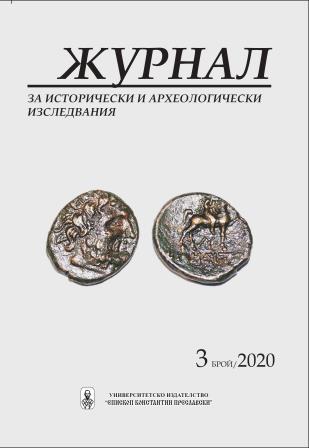Сграфито керамика от средновековната крепост и манастир край с. Драгойново и мястото ѝ в керамичния комплекс на Южна България
Sgraffito Pottery from Middle Ages Fortress and Monastery Near Dragoynovo Village and Its Place in the Ceramic Complex of Southern Bulgaria
Author(s): Rumen Ivanov, Georgi TomovSubject(s): History, Archaeology
Published by: Шуменски университет »Епископ Константин Преславски«
Keywords: Dragoynovo; sgraffito pottery; Byzantine
Summary/Abstract: The subject of the present paper is a sgraffito pottery collection that originates from regular archeologic excavations at the Late Antiquity and Middle Ages fortified settlement near the nowadays Dragoynovo Village, Parvomay Province, Plovdiv Region, Central Southern Bulgaria. The sgraffito pottery comes from well-stratified levels and covers the period from the early 12th to the early 13th c. The sgraffito pottery from Dragoynovo haven’t been published so far and the ceramic typology presented in this paper can be considered as complete and representative, both stylistically and as far as quantities of wares are concerned. Forms of vessels, specific decoration and designs are described. Their chronology is based on analogies with similar finds from Byzantine territories. The presented pottery types from Dragoynovo belongs to the Middle Byzantine Period Sgraffito Pottery – “Fine sgraffito ware”, “Painted fine sgraffito”, “Champlevé ware” and “Zeuxippus Ware”. The Zeuxippus Ware fragments are identified as Class I, monochrome (IA with colourless glaze). The only one repaired sgraffito vessel in this collection is a dark green glazed dish with an oblique brim and hollow bottom (dimensions: 5.5x25.4 cm, diam. of foot: 8.5 cm). The inner surface of the dish is decorated with stylized figure of lioness performed by slip incisions with a sharp tool. Both as technology and style the dish is corresponding with the typical fine sgraffito production (developed style) from the 2nd half of the 12th century. Although lions/lionesses appeared frequently in Byzantine secular and religious art, the boldly stylized pose of the lioness and the specific dark green glaze suggests influence from the decorative vocabulary of the Islamic World. The contribution of this paper can be summarized as follows: 1) It presents unpublished pottery in a complete chronological sequence from the 12th to the early 13th c. from a new site in the Central Southern Bulgaria, offering comparative material for the study of the pottery in the region; 2) It provides new evidence for the history of Dragoynovo fortified settlement, its changing role and decline after the Fourth Crusade (1202–1204); 3) It presents unique mid-12th century sgraffito ware in fine developed style decorated with lioness figure without specific analogue among the known Byzantine sgraffito ceramic from that period.
Journal: Журнал за исторически и археологически изследвания
- Issue Year: 2020
- Issue No: 3
- Page Range: 45-55
- Page Count: 14
- Language: Bulgarian

